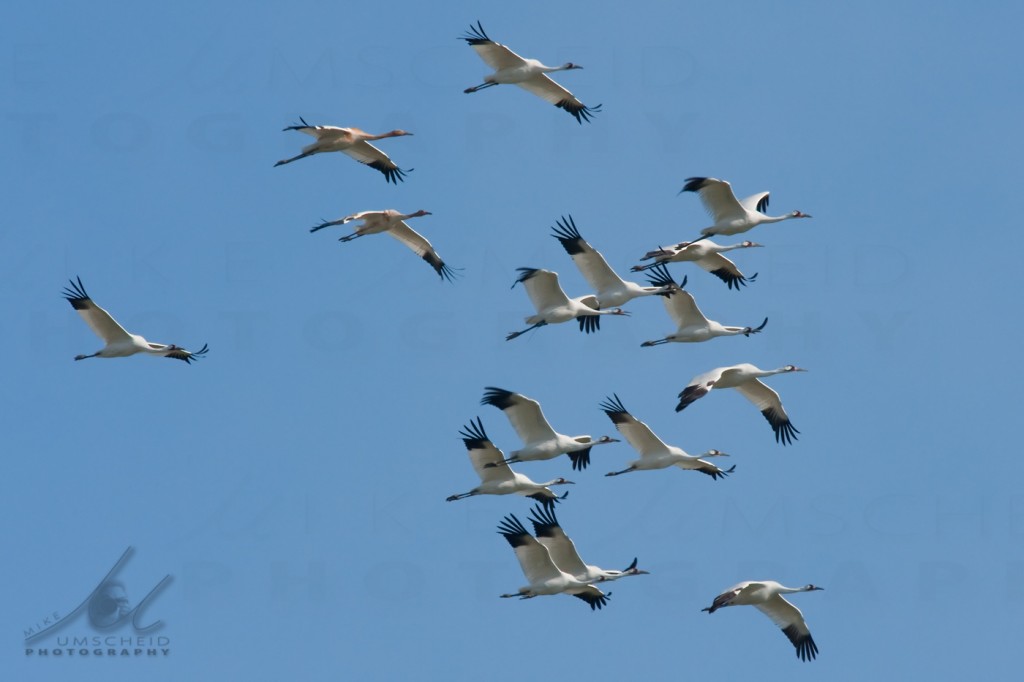by Chester McConnell
Whooping Crane Conservation Association
Getting good photographs of members of the Aransas-Wood Buffalo flock of whooping cranes is not easy. First they are wild and cautious. And then there are so few of them (about 300). Generally they are in locations not easy to get to. During this time of year the whoopers are migrating from their nesting habitat in Wood Buffalo National Park, Canada to Aransas National Wildlife Refuge along the Texas coast. They may be observed anywhere along the 2,400 mile migratory route if you are lucky.
Photographer Mike Umscheid is one of those lucky people but I believe that his luck improves the harder he works. Mike recently made some excellent photos of whooping cranes and agreed to share them with the Whooping Crane Conservation Association (WCCA).
Mike’s photo shown below is very unusual because there are 16 whoopers flying together. Two more were with the group. Normally whooping cranes fly in groups of 2 to 8, so a photograph of 16 together is very unlikely.
WCCA communicated with Mike and we share with you his excitement about his recent encounter with the cranes. Mike advised: “I’ve visited the WCCA website before, even before I photographed those cranes, in gathering information on movement of the whoopers, the latest flock numbers, etc. I’ve fallen in love with the whooping crane and it is a bird that I have always wanted to photograph. Needless to say, it was an absolute treasure being around them and having them fly above me (let alone photographing them).”
Mike continues: “I was out at Quivira (National Wildlife Refuge, Kansas) photographing cranes for a couple of days recently. The surge of cranes began to arrive there earlier last week. The whooper numbers peaked at 18, and all 18 of them were on the Little Salt Marsh (LSM) at that time. The day before, my partner (Jim Glynn), and I photographed 3 whoopers as they flew just about directly overhead as they lifted off to feed around 10:30 in the morning. I got some fairly nice nearly frame-filling images of these birds in flight.” (WCCA has omitted the specific times and locations of the whooping cranes to help prevent possible harassment of the birds. Most whooper visits occur overnight and are gone from the area by mid-morning the next day.)
After photographing the many sandhills on Big Salt Marsh (BSM), Mike and Jim slowly made their way to another site to see if they could observe the whoopers again. Sure enough, they located them again way out in the middle of a marsh. Mike explained: “At first there were two subgroups of 13+5, but then they all converged before taking flight to head south. The 16 adults and 2 juveniles took flight, a scene I’ll never forget. We were repositioning ourselves as they lifted off, so I didn’t get any images of the lift off, as the flapping, stark black wing tips were lined up one by one like a series of aircraft departing off a runway. We grabbed some amazing in flight shots in good front light as they were flying towards us — all 18 of them!”
Mike added, “In several of my images, I noticed one adult did have a GPS tracking unit on one of its legs and was banded. All the other birds were device/banded free. It was a moment I never anticipated I would get to experience, and I have only had my 600mm lens for less than a month! All my in-flight images were shot with a Nikon D3, 600mm f/4 lens with 1.4x teleconverter.


